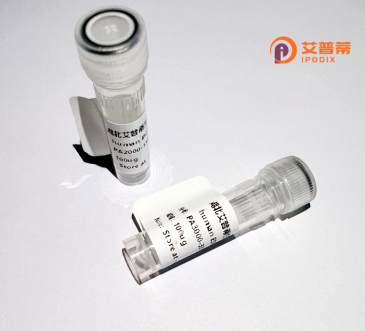
| 纯度 | >90%SDS-PAGE. |
| 种属 | Human |
| 靶点 | IL1F6 |
| Uniprot No | 0 |
| 内毒素 | < 0.01EU/μg |
| 表达宿主 | E.coli |
| 表达区间 | 1-158aa |
| 氨基酸序列 | MEKALKIDTPQQGSIQDINHRVWVLQDQTLIAVPRKDRMSPVTIALISCRHVETLEKDRGNPIYLGLNGLNLCLMCAKVGDQPTLQLKEKDIMDLYNQPEPVKSFLFYHSQSGRNSTFESVAFPGWFIAVSSEGGCPLILTQELGKANTTDFGLTMLF |
| 分子量 | 44.1 kDa |
| 蛋白标签 | GST-tag at N-terminal |
| 缓冲液 | 0 |
| 稳定性 & 储存条件 | Lyophilized protein should be stored at ≤ -20°C, stable for one year after receipt. Reconstituted protein solution can be stored at 2-8°C for 2-7 days. Aliquots of reconstituted samples are stable at ≤ -20°C for 3 months. |
| 复溶 | Always centrifuge tubes before opening.Do not mix by vortex or pipetting. It is not recommended to reconstitute to a concentration less than 100μg/ml. Dissolve the lyophilized protein in distilled water. Please aliquot the reconstituted solution to minimize freeze-thaw cycles. |
以下是关于重组人IL1F6(IL-36α)蛋白的3篇代表性文献:
1. **文献名称**:*IL-36α (IL-1F6) is expressed in human epidermis and promotes proinflammatory responses in keratinocytes*
**作者**:Debets R. 等
**摘要**:该研究首次报道了IL1F6(IL-36α)在人类皮肤表皮中的表达,发现其通过激活NF-κB和MAPK信号通路诱导角质形成细胞产生炎症因子(如IL-8和IL-6),提示其在银屑病等炎症性皮肤病中的作用。
2. **文献名称**:*Identification of recombinant human IL-1F6 pro-inflammatory activity using a novel in vivo bioassay*
**作者**:Towler P. 等
**摘要**:研究通过重组表达人IL1F6蛋白,开发了一种新型小鼠炎症模型,证明该蛋白能显著诱导局部炎症反应,并发现其活性依赖于IL-36受体复合物,为相关疾病治疗提供了实验依据。
3. **文献名称**:*Production and functional characterization of recombinant human IL-36γ/IL-1F9*
**作者**:Ramadas R.A. 等
**摘要**:尽管标题为IL-36γ(IL1F9),但文中对比了IL-36家族成员(包括IL1F6/IL-36α)的表达与功能,利用大肠杆菌系统成功纯化重组蛋白,证明其在气道上皮细胞中增强Th2型免疫反应的能力。
---
**备注**:IL1F6现属IL-36家族亚型,检索时建议同时使用新旧命名(如IL-36α);若需具体实验方法(如蛋白表达体系),可进一步筛选侧重重组蛋白制备的文献。
Interleukin-1 family member 6 (IL1F6), also known as IL-36α, is a pro-inflammatory cytokine belonging to the IL-1 superfamily. It is part of the IL-36 subfamily, which includes IL-36α, IL-36β, IL-36γ, and the receptor antagonist IL-36Ra. IL1F6 is primarily expressed in epithelial tissues, particularly the skin, lungs, and intestines, where it plays a role in immune responses to pathogens and tissue damage. It signals through the IL-36 receptor (IL-36R), which forms a complex with the IL-1 receptor accessory protein (IL-1RAcP), activating downstream pathways like NF-κB and MAPK to induce production of inflammatory mediators, antimicrobial peptides, and chemokines.
Research highlights its importance in skin inflammation, psoriasis, and wound healing. Dysregulated IL1F6 signaling is implicated in chronic inflammatory diseases, such as psoriasis, where overexpression triggers keratinocyte activation and immune cell infiltration. Recent studies explore its dual role: while excessive IL-36α drives pathology, controlled activity may aid host defense. Recombinant human IL1F6 protein is widely used in vitro and in vivo to model inflammatory mechanisms, screen therapeutic agents, or study receptor interactions. Produced via eukaryotic expression systems (e.g., HEK293 cells) to ensure proper post-translational modifications, it retains bioactivity validated by cell-based assays. Therapeutic strategies targeting IL-36 signaling, including receptor blockers and monoclonal antibodies, are under clinical investigation for psoriasis and other autoimmune disorders.
×